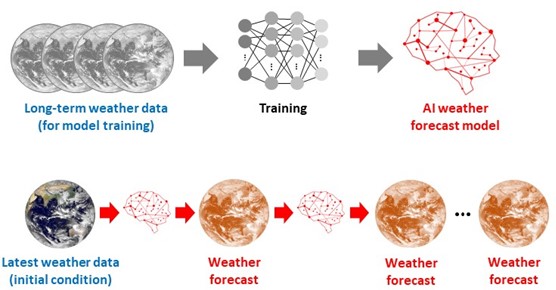Weather Forecast Based on Artificial Intelligence
Weather Forecast Based on Artificial Intelligence
LEUNG Yu-ting and Ho Cheuk-hang
October 2024
Artificial intelligence (AI) has been applied to numerous sectors in recent years. The rapid developments of machine learning and deep learning algorithms enable the use of complex big data. Weather forecasting based on AI techniques has become a hot topic in meteorological research, and notable advancement was made in the past couple of years. The Hong Kong Observatory (HKO) has been actively exploring and assessing the applications of AI in weather forecasting. HKO has introduced and began real-time trial operation of various AI models since mid-2023, and provided their forecast products progressively in the “Earth Weather” webpage.
Prediction of change in weather in the next few days relies heavily on the output results of numerical weather prediction (NWP) models. Conventional NWP models simulate weather evolution by solving physical equations. The simulation is very complex with a huge amount of calculations, requiring the use of high-performance computers. Computer models such as European Centre for Medium-Range Weather Forecasts (ECMWF), National Centers for Environmental Prediction (NCEP), and United Kingdom Meteorological Office (UKMO) that are often mentioned, are conventional NWP models.
AI weather prediction models make use of large volume of past weather data to train large model through machine learning algorithms such as artificial neural network (Figure 1), so that the AI models learn the patterns and relationships of weather evolution that can be used to predict future weather changes. Generally speaking, the larger amount and the higher accuracy of the training data, the better performance the AI models will gain. Current generation of AI models employ around 40-year global reanalysis data for the training, which includes around 25 trillion data points. Training of AI model requires a lot of computing resources and massive amount of data. Once the training process is completed, AI weather prediction models can produce forecast results faster than conventional NWP models.

Figure 1 Flow of model training and weather forecasting of AI models.
A preliminary statistical assessment by HKO showed that AI models have reached or even slightly surpassed the performance of conventional NWP models in forecasting large-scale weather evolution for 10 days ahead. Additionally, AI models generally outperformed conventional NWP models in the forecasts of tropical cyclone tracks with smaller errors (Figure 2).

Figure 2 Track forecasts of Super Typhoon Saola in 2023 by mainstream conventional NWP models (left) and AI model “Pangu”[1] (right).
Up to now, AI models still face various challenges and limitations in weather forecasting. The current generation of AI models only provides a limited set of atmospheric elements such as winds, temperatures, and pressures. In addition, AI models tended to underestimate tropical cyclone intensity. Furthermore, the capability of AI models in predicting extreme weather events has yet to be verified because of their rare occurrence in history, not to mention record-breaking weather events were not present in AI models’ training data.
The application of AI in weather forecasting is still at a preliminary stage. The Observatory will continue to promote the use of AI with a view to further enhancing the quality of weather services.
Note :
[1] For more information on “Pangu” model, please refer to the following article: Bi, K., Xie, L., Zhang, H. et al. Accurate medium-range global weather forecasting with 3D neural networks. Nature 619, 533–538 (2023).
[1] For more information on “Pangu” model, please refer to the following article: Bi, K., Xie, L., Zhang, H. et al. Accurate medium-range global weather forecasting with 3D neural networks. Nature 619, 533–538 (2023).